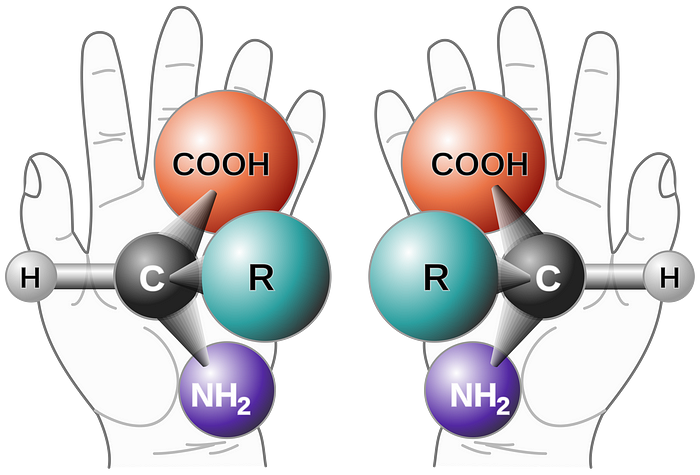
Half a century ago, we were advised jokingly to never shake hands with aliens, because they might be made of antimatter. In that case, touching them would lead to mutual annihilation. Today, thanks to advances in gamma-ray and cosmic-ray astronomy, we know that antimatter is a negligible constituent in the cosmic mass budget. These circumstances are well understood in the context of the dense early phase of the Universe, when all traces of antimatter annihilated with matter, leaving behind a tiny (six parts in ten billion) excess of matter that accounts for what we observe in the Universe today.
But there is another important reason to avoid contact with extraterrestrial life: it could be a mirror image of terrestrial life.
In 1848, the chemist Louis Pasteur discovered that some molecules essential for life exist in mirror image forms. The two forms are referred to as “left-handed” and “right-handed” where the handedness, or chirality, refers to the direction in which polarized light rotates as it propagates through a solution of the molecules. Biology on Earth broke the symmetry and chose homochirality, representing just one of these chiral forms. DNA, RNA, and their building blocks are all right-handed, whereas amino acids and proteins are all left-handed. The symmetry breaking could have occurred before or after life emerged. This uncertainty might be resolved once we discover life beyond Earth.
If extraterrestrial life is found to have equal probabilities for being left-handed or right-handed, then we would know that the symmetry was accidentally broken on Earth in a way that made one handedness dominate terrestrial ecology. It would also suggest that the transfer of life between planets, called panspermia, is insignificant, as it would have naturally led to a single dominant handedness in systems that share a common heritage.
A new Policy Forum article co-authored by 38 leading experts in the journal Science alerts to the existential risk from mirror life, based on a 299-page technical report titled: “Mirror Bacteria: Feasibility and Risks”. In mirror bacteria, the DNA, RNA, amino acids and proteins are replaced by their mirror images. Future advances in synthetic biology could lead to the production of mirror bacteria. Their interactions with natural organisms would be different from the interactions of natural bacteria with natural organisms. Immune defenses rely on interactions between chiral molecules that could fail to detect or kill mirror bacteria. As a result, mirror bacteria might spread throughout the ecology of natural terrestrial life, unchecked by natural biological controls. The mirror bacteria would appear as dangerous pathogens for a wide range of natural life forms, including humans. The report details the resulting risks to the health of humans, other animals and plants, as well as potential ecological consequences. Based on that, the Science policy article concludes: “Unless compelling evidence emerges that mirror life would not pose extraordinary dangers, we believe that mirror bacteria and other mirror organisms, even those with engineered biocontainment measures, should not be created. We therefore recommend that research with the goal of creating mirror bacteria not be permitted, and that funders make clear that they will not support such work.”
But what if nature created mirror life on another planet? Should we be worried about this mirror life being delivered to our home planet inside a rock or a Mars Sample Return mission? This would constitute the interplanetary analog of Amazon delivery services, with a package that includes content we never ordered.
What happens naturally on other planets is under no obligation to satisfy the recommendation of the 38 authors of the Science article. One thing is clear: if any rocks with traces of mirror life were ever delivered to Earth over the past 4.2 billion years since the appearance of the Last Universal Common Ancestor (LUCA), terrestrial life managed to survive their potential harms. Otherwise, mirror cyanobacteria which feed on non-chiral nutrients and sunlight, could have dominated Earth’s ecosystem by producing mirror versions of common sugars. Mirror animals would have fed on mirror food, produced by mirror plants. It is possible that no package with mirror life arrived at Earth, because a universal mechanism favors the same homochirality for life everywhere.
As of now, the new technical report and Science policy article imply that we should be careful when handling material which potentially carries traces of extraterrestrial life. This important caution should be kept in mind when handling Mars sample return, NASA’s and ESA’s ambitious, multi-mission campaign.
The health risk should also be kept in mind when following Elon Musk’s inspiring vision to occupy Mars and make humans a multi-planet species. The possibility that the Martian soil might contain relics of mirror life, adds to the known health risks from energetic cosmic-rays and extreme temperature variations between day and night on the surface of Mars.
Until we know that homochirality is universal, we should be careful in our first contact with extraterrestrial life.
ABOUT THE AUTHOR

Avi Loeb is the head of the Galileo Project, founding director of Harvard University’s — Black Hole Initiative, director of the Institute for Theory and Computation at the Harvard-Smithsonian Center for Astrophysics, and the former chair of the astronomy department at Harvard University (2011–2020). He is a former member of the President’s Council of Advisors on Science and Technology and a former chair of the Board on Physics and Astronomy of the National Academies. He is the bestselling author of “Extraterrestrial: The First Sign of Intelligent Life Beyond Earth” and a co-author of the textbook “Life in the Cosmos”, both published in 2021. The paperback edition of his new book, titled “Interstellar”, was published in August 2024.
